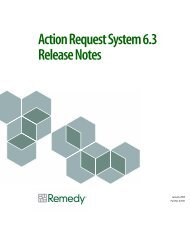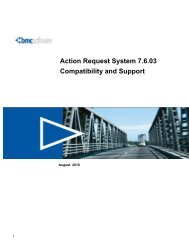BMC Remedy Action Request System 7.6.04: BMC Remedy Mid Tier ...
BMC Remedy Action Request System 7.6.04: BMC Remedy Mid Tier ...
BMC Remedy Action Request System 7.6.04: BMC Remedy Mid Tier ...
Create successful ePaper yourself
Turn your PDF publications into a flip-book with our unique Google optimized e-Paper software.
Setting limits on reports that users save<br />
Setting limits on reports that users save<br />
Users can create and save reports for forms in a browser with the My Reports<br />
toolbar button. (See “Using the My Reports toolbar button” on page 166.) The<br />
larger the number of forms and saved report sequences, the more memory is<br />
required on the mid tier.<br />
To limit the number of forms and saved report sequences cached for faster user<br />
access, edit the arsystem.myreport.report_cache_limit property in the<br />
config.properties file. This property indicates the number of “My Reports”<br />
definitions to cache per form. For example, if you set the property to 20 (the<br />
default), a maximum of 20 “My Reports” definitions are saved in the cache for a<br />
given form. The cached definitions allow faster report generation but take up midtier<br />
memory for caching.<br />
Backward compatibility<br />
Macros stopped being supported in the AR <strong>System</strong> 5.x release. You can view<br />
reports created using run macro report actions with releases prior to AR <strong>System</strong><br />
5.x in <strong>BMC</strong> <strong>Remedy</strong> User, or on the Web, by converting them to an equivalent<br />
active link.<br />
Macro conversion procedure<br />
Running the conversion procedure for a run macro report action creates an<br />
equivalent active link, which you will be prompted to name. The report content<br />
and layout (definition) become automatically embedded within the active link<br />
during the conversion, and no additional entries are required. After the active link<br />
is created, it can then be attached to a workflow trigger, such as a button field, and<br />
placed on a form.<br />
For details about the macro conversion procedure, see the Workflow Objects Guide,<br />
“Run Macro action,” page 123.<br />
For instructions on attaching active links to a workflow trigger, such as a button<br />
field, see “To attach an Open Window active link to a form with a button field” on<br />
page 104.<br />
For information about backward compatibility related to localization, see the<br />
“Backward compatibility” on page 113.<br />
Localized reports created using macros<br />
If you have language-specific reports created using Run Macro report actions with<br />
releases prior to AR <strong>System</strong> 5.x, perform the following steps to make them<br />
available to users:<br />
1 Convert the run macro report action to an equivalent active link.<br />
Chapter 4 Configuring AR <strong>System</strong> for Web and AR <strong>System</strong> reports 113





